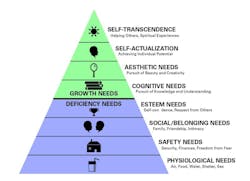Look to Maslow’s Hierarchy to See Design and Architecture Impacts
For several decades, interior design educators have integrated into their spatial sciences and environmental psychology curriculum the five-tier Maslow’s hierarchy of needs, introduced by psychologist Abraham Maslow in his 1943 paper “A Theory of Human Motivation” in Psychological Review.
The five-tier system provided a way of understanding how architecture and interiors could help building occupants meet their psychological needs while also providing a basic means to evaluate the impact of built space upon the human psyche.
Most researchers, and Maslow is no exception, develop theories iteratively over the course of many years. The five-part Maslow’s hierarchy of needs that is commonly referenced today was one of the first iterations, and, from basic to advanced, is:
1. Physiological needs
2. Safety needs
3. Social/belonging needs
4. Esteem needs
5. Self-actualization
Expanding the Hierarchy of Needs
For its time, and still today, this psychological theory offered a useful framework to help researchers understand human behavior. The theory was not fully developed, however, and Maslow kept working at it.
Meanwhile, the early iteration was received favorably, and quickly spread through many areas of psychology, including environmental psychology and interior design and architectural studies.
At first, Maslow’s main concern was with the top tier, self-actualization—he didn’t think that was the pinnacle of the framework. As he furthered the research, he saw that self-transcendence, was a higher, and separate, need.
The initial revision to the research included cognitive and aesthetic needs within self-transcendence, but these were separated out as distinct needs in later iterations of the theory.
As the broader community, including architecture and design, latched on to the first iteration of the theory, they missed the later developments. Today, the theoretical framework includes eight parts that are divided into deficiency needs and growth needs:
Deficiency Needs:
1. Physiological needs
2. Safety needs
3. Social/belonging needs
4. Esteem needs
Growth Needs:
5. Cognitive needs
6. Aesthetic needs
7. Self-actualization
8. Self-transcendence
This diagram, was created by the author based upon work from Ting Zhang and Hua Dong noted in Human-Centred Design: An Emergent Conceptual Model.
If an individual found that any of their first four needs were in deficiency, then they wouldn’t be able to effectively pursue their growth needs for a sustained period of time.
How Maslow’s Hierarchy Impacts Interiors and Architecture
This expanded understanding of Maslow’s hierarchy of needs has the potential to greatly impact the practice of design and architecture.
- For users, built space directly offers the opportunity to address the functional needs embodied in the first five tiers of the framework.
- For user and practitioner, design practice addresses our communal need for beauty and aesthetics.
On its own, built space can’t realistically be expected to achieve self-actualization for the user, but design practice could help the practitioner meet his or her full potential (self-actualization) as a professional.
[Read also: Radical Innovation 2019 Finalists for Futuristic Hotel Concepts]
As professionals, we design places that help our users to meet all eight of these needs for themselves. One could argue that this quality inherent to the practice of design and architecture allows the practitioner to achieve their own need for self-transcendence.
In the process of writing the book Interior Design Fundamentals, I realized the body of knowledge was outdated and that the discipline could greatly benefit from working with the updated eight-tier model of Maslow’s Hierarchy of Human Needs.
The book is comprised of 12 chapters geared toward the early design student, including a chapter on spatial well-being that addresses a variety of topics, including Maslow’s hierarchy of needs.
For further understanding on this topic, and to see how it can relate to other theories of environmental psychology, please consider reading the chapter in the book.
Look Back to Move Forward
The process of design and design research are both iterative. As a result, we need to occasionally look back at some of our foundational principles and theories, many of which come from outside our discipline, to see if they have grown over time.
In this case, looking in the rear view has produced further confirmation that design is engrained in the human psychology, that our pursuit of our basic needs can be met through the built environment and that same built environment can help us meet our growth needs.
Read next: Designer Jhane Barnes Weaves Math and Sustainability Throughout a Successful Career
About the author:
References:
Koltko-Rivera, M. E. (2006). Rediscovering the later version of Maslow's hierarchy of needs: Self-transcendence and opportunities for theory, research, and unification. Review of General Psychology, 10(4), 302-317.
Maslow, A. H. (1943). A theory of human motivation. Psychological Review, 50, 370–396.
Maslow, A. H. (1954). Motivation and personality. New York: Harper.
Maslow, A. H. (1969). The farther reaches of human nature. Journal of Transpersonal Psychology,
1(1), 1–9.
Maslow, A. H. (1979). The journals of A. H. Maslow (R. J. Lowry, Ed.; Vols. 1–2). Monterey, CA:
Brooks/Cole.
Maslow, A. H. (1982). The journals of Abraham Maslow (1-vol. ed.; R. J. Lowry, Ed., & J. Freedman,
Abridger). Brattleboro, VT: Lewis.
Zhang, T., & Dong, H. (2009). Human-centred design: an emergent conceptual model.
